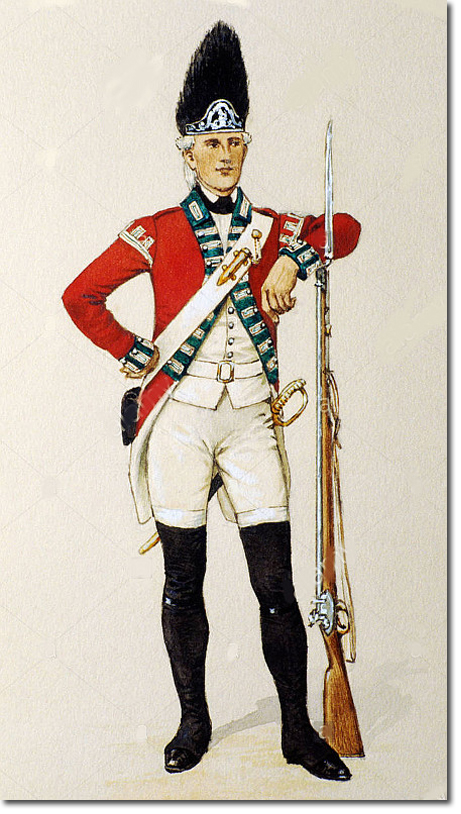|
|


|
|
The Clothing Warrant of 1768 instituted significant changes to infantry uniform. Grenadier caps were changed from the cloth mitre type to black bearskin. The universal metal plate at the front was black with silver devices; the royal crest flanked by G R and a motto NEC ASPERA TERRENT. On the back was a red patch with a grenadier badge and number 19. The coats, worn over a white waistcoat, were more close-fitting, with a turned-down collar. Lapels were 3 inches wide down to the waist and cuffs were neat with buttons and button lace. On the shoulders were flank company wings decorated with button lace. This lace had changed pattern once more, as from 1768. There is a lace book in the Royal Library at Windsor which has actual examples of the lace for each regiment, sewn onto cloth of the facing colour. Unfortunately there are no coloured pictures of these samples available, but a description in Hew Strachan’s book on British Military Uniforms 1768-96 says that the wider line on the outside of the lace is a red and olive line side by side. The thin line on the inside is red and olive intertwined. The backing cloth which represents the facings of the coat is ‘deep, slightly brownish green’. This does not match up with the colour of the facings in this late-19th century illustration by P W Reynolds.
The grenadier leans on the muzzle of his musket which is described as the Old English Long musket. The barrel length was 46 inches and fired balls of .75inch calibre. The rate of fire was considered to be 3 per minute, using cartridges. The weapon weighed 10 pounds and had a 17 inch ring or socket bayonet. He carries a sword hung from a waist-belt. This was abolished for battalion companies in 1768 but grenadiers continued to carry them until the 1790s. The shoulder belt supported his ammunition pouch, and had the brass tube attached to the front which used to hold the lighted taper for the grenades but by this time it was more decorative and traditional. |
Armed Forces | Art and Culture | Articles | Biographies | Colonies | Discussion | Glossary | Home | Library | Links | Map Room | Sources and Media | Science and Technology | Search | Student Zone | Timelines | TV & Film | Wargames